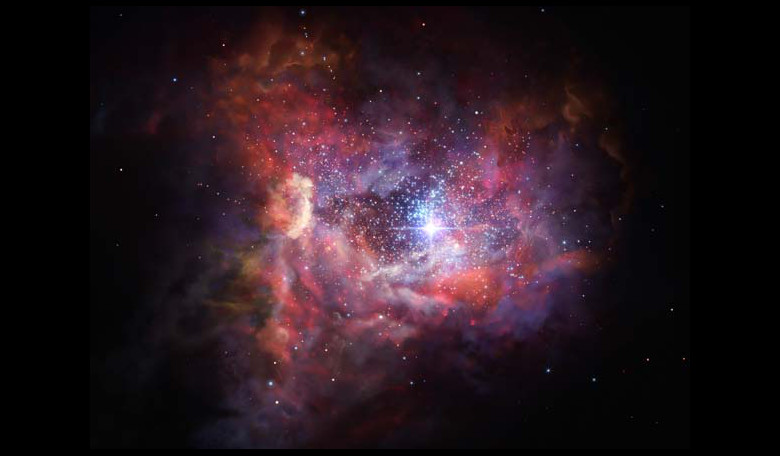Astronomers have detected a huge mass of oxygen-containing glowing stardust, in a galaxy seen when the Universe was only four percent of its present age.
The international team of astronomers, led by Nicolas Laporte of University College London, used the Atacama Large Millimeter/submillimeter Array (ALMA) to observe the youngest and most remote galaxy ever seen by this observatory to provide brand-new insights into the lifecycle of the very first stars.
Known as A2744_YD4, this young galaxy appears to us as it was when the Universe was only 600 million years old, and it is populated with an abundance of interstellar dust mainly composed of silicon, carbon and aluminium. The dust grains are as small as a millionth of a centimetre across and are formed by an earlier generation of stars as they reach the end of their lives. “Not only is A2744_YD4 the most distant galaxy yet observed by ALMA,” said Nicolas Laporte, “but the detection of so much dust indicates early supernovae must have already polluted this galaxy.”
Dust is an essential building block in the formation of stars, planets and complex molecules and today it is scattered ubiquitously throughout the Universe. However in the very early years following the formation of the Universe — before the first generations of stars died out — it was a scarce commodity.
The team estimates that the mass of all of the stars in A2744_YD4, i.e the total stellar mass equates to about 2 billion times the mass of our Sun, while the amount of dust in the galaxy is equivalent to 6 million times the mass of our Sun.
Laporte and team also found that stars are forming in A2744_YD4, which has been nicknamed Pandora’s Cluster, at a rate of 20 solar masses per year — compared to just one solar mass per year in the Milky Way. Put another way, it means that the total mass of the stars formed every year is equivalent to 20 times the mass of the Sun.
“This rate is not unusual for such a distant galaxy, but it does shed light on how quickly the dust in A2744_YD4 formed,” explains Richard Ellis, a co-author of the study from ESO and University College London. “Remarkably, the required time is only about 200 million years — so we are witnessing this galaxy shortly after its formation.”
ALMA is designed to study light in the millimeter and submillimeter range of the electromagnetic spectrum, which is the wavelength that dust molecules emit their photons in, therefore the observatory is perfectly suited to help study the era when the first stars and galaxies “switched on.”
“With ALMA, the prospects for performing deeper and more extensive observations of similar galaxies at these early times are very promising,” says Ellis.
“Further measurements of this kind offer the exciting prospect of tracing early star formation and the creation of the heavier chemical elements even further back into the early Universe,” added Laporte.











